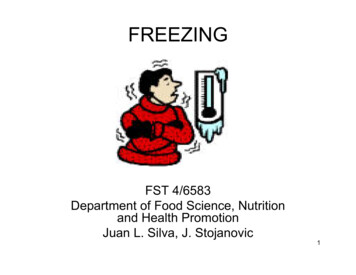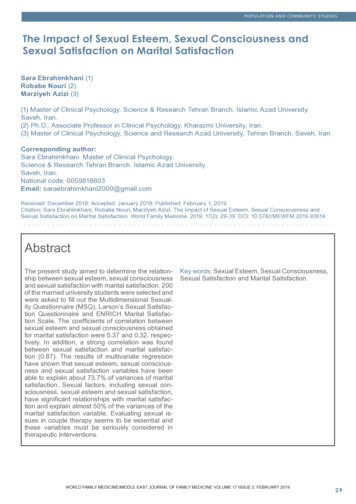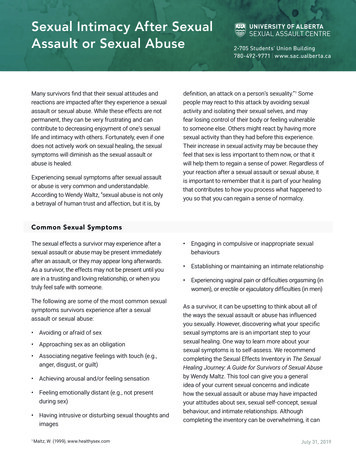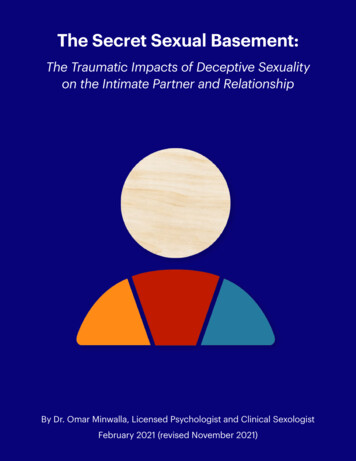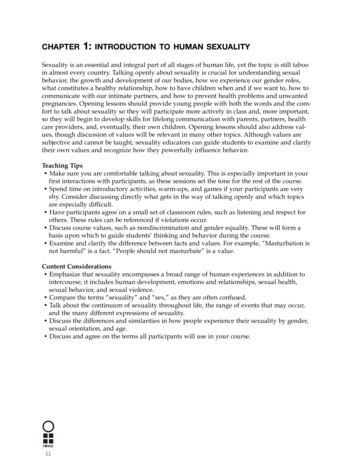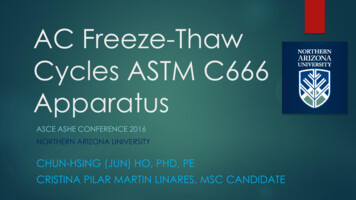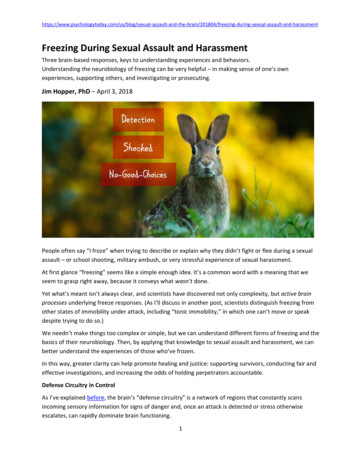
Transcription
g‐sexual‐assault‐and‐harassmentFreezing During Sexual Assault and HarassmentThree brain‐based responses, keys to understanding experiences and behaviors.Understanding the neurobiology of freezing can be very helpful – in making sense of one’s ownexperiences, supporting others, and investigating or prosecuting.Jim Hopper, PhD – April 3, 2018People often say “I froze” when trying to describe or explain why they didn’t fight or flee during a sexualassault – or school shooting, military ambush, or very stressful experience of sexual harassment.At first glance “freezing” seems like a simple enough idea. It’s a common word with a meaning that weseem to grasp right away, because it conveys what wasn’t done.Yet what’s meant isn’t always clear, and scientists have discovered not only complexity, but active brainprocesses underlying freeze responses. (As I’ll discuss in another post, scientists distinguish freezing fromother states of immobility under attack, including “tonic immobility,” in which one can’t move or speakdespite trying to do so.)We needn’t make things too complex or simple, but we can understand different forms of freezing and thebasics of their neurobiology. Then, by applying that knowledge to sexual assault and harassment, we canbetter understand the experiences of those who’ve frozen.In this way, greater clarity can help promote healing and justice: supporting survivors, conducting fair andeffective investigations, and increasing the odds of holding perpetrators accountable.Defense Circuitry in ControlAs I’ve explained before, the brain’s “defense circuitry” is a network of regions that constantly scansincoming sensory information for signs of danger and, once an attack is detected or stress otherwiseescalates, can rapidly dominate brain functioning.1
That circuitry includes the amygdala and several other structures (e.g., specific brainstem areas). That’swhy it’s called a circuitry. And it can trigger many responses in the brain and body – much more than couldever be conveyed by the phrase “fight or flight” (or the newly popular “fight, flight, freeze”).Some of those brain responses are part of any reaction to danger and being attacked, including all freezeresponses. Others are unique to particular types of freezing.Three Types of FreezingScientists broadly define freezing as a response to threat characterized not only by immobility, but alsoinhibition of behavior. In the laboratory researchers evoke freezing in different ways, some involving theability to escape and others inescapable. (To dig into the leading research, use the references below.)By reading the scientific literature closely, and listening carefully to people describing responses they’vehad to sexual assault, severe harassment, and other attacks, it’s possible to differentiate three types offreezing: detection, shocked, and no‐good‐choices.As we’ll see, someone who says “I froze” may have experienced one, two, or all three forms. And forneurobiological reasons, if more than one happens, they typically unfold in a set order.Detection FreezingIn sexual assaults and severe harassment there’s often a critical moment when the attack is detected andbrain and body instantly and automatically enter a completely different state.Up to that point, the person may have experiencedwhat was happening (even if it was unpleasant,unwanted, and somewhat stressful) as basically normaland consistent with their expectations of how things goin such situations: how people tend to kiss and toucheach other in (awkward) romantic situations, howpushy dates can act, and how boorish bosses can beinappropriate.But then something happens that flips the script ormassively escalates the stress, and the brain’s defensecircuitry not only detects an unexpected attack, butautomatically and involuntarily triggers strong brainand body responses.In detection freezing, movement instantly stopsand brain and body are primed to receivepotentially life‐saving information.This is detection freezing, and to describe it peopleoften say, “I froze for a second.”I’ve heard accounts of this freezing response manytimes, like anyone else who talks with people who’ve been sexually assaulted or severely harassed. I’veencountered it as an expert for legal cases, in police reports and in recordings and transcripts ofinvestigative interviews. Military and law enforcement personnel report this freeze response too,especially to ambushes and other unexpected attacks.2
People can have this detection freeze response at different times – some when they first sensesomething’s wrong, before clear aggression, and others not until the fourth or fifth time their resistance isignored or overpowered. It can happen when an arm is grabbed, a shirt forcibly unbuttoned, or a rapistflashes a look that says, “You can’t stop me.” Or when someone getting a massage is inappropriatelytouched the first or second (definitely‐no‐accident) time.The potential triggers are limitless, but the detection freeze response is basically the same: Instantly andinvoluntarily, sometimes with a jolt, everything stops and everything changes.This response can be fleeting, and may not be recalled later – at least not initially, especially if moredisturbing experiences happened right before and afterward, or the person is generally avoiding badmemories. Often investigators don’t ask the right questions, or even know it’s a common response and akey moment in many sexual assaults. (It’s a key moment because – from then on – brain, body, attention,thinking, behavior, and memory processes are all dramatically altered in particular ways.)The detection freeze response doesn’t happen in every sexual assault or incident of severe harassment,especially if escalation and recognition unfold gradually. But when it does, a variety of other brain‐basedprocesses tend to follow.Stopping Behaviors and ThoughtsObviously the detection freeze response involves stopping all movement (aside from breathing and visualscanning). That’s why it’s called freezing.Immobility helps prey avoid the attention of predators. Just as importantly, stopping whatever behaviorswere happening just before attack was detected also makes room – literally, in terms of brain networkfunctioning – for new and unplanned behavior options that could prevent injury or death.Over millions of years, evolution sculpted a specific defense circuitry pathway which carries out that stop‐movement or “behavioral inhibition” component of freezing.Simultaneously, the defense circuitry also instantly stops any thought processes. Research suggests thishappens via rapid chemical and electrical changes in regions underlying verbal and visual thinking.Those sudden cessations of behavior and thought can be understood as a “network reset” (which isinitiated by a brainstem area, the locus coeruleus). That reset prepares the brain to receive new andpotentially life‐saving information – and generate options for responding to it.Shocked FreezingThe sudden stopping of all movement and thinking may last a fraction of a second, a couple of seconds, oreven longer. When it lasts a couple of seconds or less, that’s the detection freezing response.But when it lasts longer than a couple of seconds, additional brain processes are involved, and it’s a bigdeal. People tend to remember it.3
That’s why many people who’ve been sexuallyassaulted or severely harassed say that, at some point,“I was in shock” or “My mind went blank,” and ofcourse, “I froze.” Again, some military personnel andpolice officers say the same things about having frozenin this way (although understandably they seldomadmit such things).I’ve named this remarkable, disturbing, andmemorable state the shocked freeze response.Shocked freezing, which often immediately followsdetection freezing, is a massive “reset.” The mindis blank and no behavior options are beinggenerated (yet).It usually comes right after the detection freezeresponse, as a continuation of that “network reset” –and a massive amplification of it. For several seconds aperson may feel shocked, dumbfounded, their mindutterly blank, at a loss for words and actions. Trying todescribe it later, people say things like, “It made nosense,” “It just didn’t compute,” “I couldn’t eventhink,” or “I had no idea what to do.”Basically, in this form or phase of freezing, no options for responding even arise in the brain or awareness.It’s not that people experience themselves as having options but can’t decide among them (we’ll get tothat). Instead, their brains, at least for a time, are literally not generating any behavior options to choosefrom, let alone execute.Research suggests that the strength and length of this shocked freeze state depend on how muchnorepinephrine the defense circuitry (i.e., its locus coeruleus) has just released into brain regions thatgenerate thoughts and behaviors.Whatever the exact brain causes, it’s a helpless and horrifying state of being, especially when unwantedand disturbing things are being done to one’s body.It’s a state that people commonly describe later as having been “frozen.” And like the other two freezeresponses, it’s a state that can be listened for, explored with non‐leading questions, and put together withother information and evidence – whether to conduct a more effective investigation or simply to validatethe experience of someone who feels safe enough to share it with us.Co‐Activating the Autonomic Nervous SystemI hope you’re appreciating this fine‐grained analysis of what often happens in the first few seconds afterfreezing has been triggered by a sexual assault or other attack. It gets more interesting and illuminating.As movement and thought cease and brain networks are reset, the defense circuitry simultaneouslyactivates the autonomic nervous system by slamming on its sympathetic “accelerator” and itsparasympathetic “brake.” Scientists call this a “co‐activated mode of autonomic control.” (Theparasympathetic brake is almost always on to some extent, not just during rest and relaxation – otherwisewe’d have resting heart rates of around 110 beats per minute.)4
The parasympathetic (vagus) nerve has an insulating sheath (of myelin) that speeds its input to the heart.So when detection freezing kicks in, parasympathetic input is the first to reach the heart, and when it doesit slows it down. Once the sympathetic signal finally arrives, over a second later, the heart still doesn’tspeed up much, if at all, as long as that parasympathetic brake stays engaged.In all forms of freezing the parasympathetic branch plays a dominant role. The heart massively acceleratesonly if the defense circuitry (i.e., the amygdala’s central nucleus) releases that super‐fast parasympatheticbrake, letting loose full sympathetic activation and surges of oxygenated blood to the muscles.If you’re heading for a deer in your headlights and the deer’s brain doesn’t snap out of it and let off thatparasympathetic brake in time, there’s going to be a crash. And if you’re in shocked freezing during asexual assault, your brain is not cueing up defensive behaviors, let alone unleashing them while yankingoff the autonomic brake.If you’re in shocked freezing, that assault is going to continue, and later you’re likely to say, “I froze.”(What about that “adrenaline surge” people talk about? It takes much longer, 2‐3 minutes from attackdetection or stress onset for the adrenal glands to release adrenaline into circulation and reach the heartwith another wave of sympathetic activation on top of the sympathetic nerve’s direct input. Thus anyadrenaline surge has nothing to do with detection freezing, which kicks in instantly, or shocked freezing,which happens within a second or two.)Impaired Prefrontal CortexSo the defense circuitry stops all behavior and thought, and slams on the autonomic accelerator anddominant brake. In addition to all of that, it’s also simultaneously unleashing a surge of stress chemicalsthat can rapidly impair the brain’s rational prefrontalcortex.To engage in rational thinking our brains must drawon memories and plans, weigh options, and makeinformed decisions. But that takes time – precioustime that could mean life or death in dangeroussituations. Evolution has selected brains that canquickly shift control away from the rational‐but‐slowprefrontal cortex and to fast‐acting circuitries that runwell‐programmed habits and hard‐wired reflexes.Within just a few seconds of attack detection (orstress becoming extreme) the prefrontal cortex can bemassively impaired, even effectively taken offline.With an impaired prefrontal cortex, only veryThat’s why the military and police repeatedly trainsimple thoughts arise, about reflex and habitand drill. When they come under attack and theirresponses that are extremely reactive or passive.“rational brains” go out the window, habits and(Image from Arnsten 2015; see references.)reflexes are all that’s left. So their training must burnin effective habits they can access later (although even the best training is no guarantee).5
That’s also why, when thoughts do begin to arise again – after detection or shocked freezing have passed– they’re usually very simple thoughts, not complex rational ones.Not only that, they’re usually very simple thoughts about extreme behaviors that the defense circuitry hasjust cued up but not yet released into action (just as it hasn’t yet released the parasympathetic brake).No‐Good‐Choices FreezingMany sexual assault survivors recall how, just seconds after registering the perpetrator’s behavior as anattack or upon emerging from a brief state of shock, their thinking was severely limited.They remember having few thoughts of any kind. They recall, “All I could think was ,” and complete thatsentence with a thought or two that – later, from the perspective of a relatively functional prefrontalcortex – seem remarkably simple, even useless or ridiculous.Some remember being fixated on a single thought. All they could think was, “This can’t be happening, thiscan’t be happening ” or “It’s almost over, it’s almost over ” or “God please help me.” They had noother thoughts in their minds. Indeed, they had no ability to rationally generate and then choose fromother thoughts (about how to respond effectively).Other survivors find themselves thinking only of two completely opposite responses – both extreme andhorrifying: Scream and bring people running to a humiliating scene in my dorm room vs. lie still and quiet.Jump off the massage table and run naked out the door vs. wait for the violations to end. Fight back andrisk even worse violence vs. offer no resistance at all.In short, an impaired prefrontal cortex leaves many people – whether within seconds of the initialdetection freeze response, or upon emerging from the shocked freeze response, or otherwise beingextremely stressed or terrified – with thinking that’s been reduced to extreme lose‐lose options, to“choices” that are no real choices at all.This is the third form and often the final phase of freezing during sexual assault, severe sexual harassment,and other experiences of violence and trauma. For the reasons explained above, I call it no‐good‐choicesfreezing.As explained in a 2015 article in the Harvard Review of Psychiatry, all freezing is “fight‐or‐flight put onhold.” The no‐good‐choices freeze response, with prefrontal cortex impairment and fight‐or‐flight optionscued up but on hold, corresponds to neuroscientist Karen Roelofs’ phrase, “freeze for action.”What’s held back from release into action? Habit behaviors and survival reflexes that have beenautomatically cued up by the same defense circuitry that’s also impaired the prefrontal cortex (therebyensuring that only habits and reflexes are available).More rational and potentially effective thoughts and behaviors – assuming that any are possible, which isunlikely if the perpetrator is bigger, stronger, willing to escalate the violence – don’t even arise as optionsin the brain or mind.6
Unlike well‐trained soldiers, who learn effective habitsfrom extensive combat training, most people beingsexually assaulted have no effective habits forresponding, because they’ve had no good self‐defensetraining specifically for resisting sexual assault,especially by someone they know. With brains thathave no effective habit behaviors to automatically callup and choose from, it’s no wonder they do nothing.In no‐good‐choices freezing, with an impairedprefrontal cortex and only extreme options inmind, no resistance happens. It’s a dark place andno one should be judged for getting stuck there.Later, others may ask or think, “Why didn’t you?” The answer: Because it never evenoccurred to them. Again, in response to that “whydidn’t you” question, sexual assault survivorscommonly say, “I froze. All I could think was ,” andcomplete that sentence with a simple thought or twoabout potential behaviors that were not even goodoptions.(Sometimes in no‐good‐choices freezing, theparasympathetic braking influence on the heart is outgunned by the sympathetic nerve and a late‐arrivingsurge of adrenaline. People say things like, “my heart was pounding out of my chest!” or “I was in a totalpanic!” But even then, even if the parasympathetic brake came off, in no‐good‐choices freezing thosecued‐up extreme behavior options were still inhibited from release. The body was still “frozen.”)For these biological reasons, we should never expect people to behave rationally and strategically in suchstates. We shouldn’t be surprised if they froze because they were stuck on simple thoughts about extremebehaviors that were either wildly over‐reactive or totally passive.Freezing Responses: Keys to Understanding Many Incidents of Sexual Assault and HarassmentFreezing happens in many sexual assaults and incidents of severe harassment.In all three freeze responses, the brain’s defense circuitry orchestrates massive shifts in brain functioningthat have huge effects on experience and behavior. Later, attempting to understand and explain whathappened, survivors say things like, “I froze,” “I was in shock,” and “All I could think was ”In detection freezing, all movement and thinking suddenly stop. In shocked freezing, there’s a blank mindand no behaviors to choose from. In no‐good‐choices freezing, the brain has cued up only extremebehavior options and there’s little or no prefrontal cortex capacity for rationally choosing among them orcoming up with potentially more effective ones.Sure, some people immediately fight or flee when sexually assaulted or otherwise attacked. But manydon’t.Many victims are suspended for critical seconds in frozen shock, with no thoughts at all – but plenty ofterrible sensations bombarding them. Others are stuck with simple thoughts and useless “choices” ofextreme behaviors – as the parasympathetic brake stays on, no decision is made, and no action is taken. In7
many cases, only after one or more of these freeze responses does fight or flight happen, if either happensat all.Like the brain of every survivor, every incident of sexual assault or severe harassment is unique, andpeople’s responses can unfold in unique and complex ways. In the aftermath, it can be hard to figure outwhat happened, especially when memories are incomplete due to the effects of stress, trauma, alcohol orother drugs.Confronted with that complexity, understanding the three different freeze responses can be very helpful –whether we’re supporting some who’s been sexually assaulted or harassed, trying to make sense of ourown experiences, or investigating or prosecuting such violations of others.While it may take some time and effort to absorb and apply this knowledge, including through study,training, and practice, it’s definitely worth it. This knowledge can help all of us to listen with less confusionand more understanding, with less judgement and more empathy. And those are keys to supportingsurvivors, conducting effective and fair investigations, and holding perpetrators accountable.References:Amir A., Lee S. C., Headley D. B., Herzallah M. M., & Pare, D. (2015). Amygdala signaling during foraging ina hazardous environment. The Journal of Neuroscience, 35, 12994‐13005.Arnsten, A. F. T. (2015). Stress weakens prefrontal networks: Molecular insults to higher cognition. NatureNeuroscience, 18, 1376‐1385.Aston‐Jones, G., Rajkowski, J., & Cohen, J. (1999). Role of locus coeruleus in attention and behavioralflexibility. Biological Psychiatry, 46, 1309‐1320.Berntsen, G. G., Cacioppo, J. T., Quigley, K. S. (1991). Autonomic determinism: The modes of autonomiccontrol, the doctrine of autonomic space, and the laws of autonomic constraint. Psychological Review, 98,459‐487.Berntsen, G. G., Cacioppo, J. T., Quigley, K. S. (1993). Cardiac psychophysiology and autonomic space inhumans: Empirical perspectives and conceptual limitations. Psychological Bulletin, 114, 296‐322.Bouret, S., & Sara, S. J. (2005). Network reset: A simplified overarching theory of locus coeruleusnoradrenaline function. Trends in Neurosciences, 28, 574‐582.Choi, J. S., & Kim, J. J. (2010). Amygdala regulates risk of predation in rats foraging in a dynamic fearenvironment. Proceedings of the National Academy of Sciences, 107, 21773‐21777.Dayan, P., & Yu, A. J. (2006). Phasic norepinephrine: a neural interrupt signal for unexpected events.Network: Computation in Neural Systems, 17, 335‐350.Devauges, V., & Sara, S. J. (1990). Activation of the noradrenergic system facilitates an attentional shift inthe rat. Behavioural Brain Research, 39, 19‐28.Guedj, C., et al. (2017). Boosting norepinephrine transmission triggers flexible reconfiguration of brainnetworks at rest. Cerebral Cortex, 27, 4691‐4700.8
Hagenaars, M. A., Oitzl, M., & Roelofs, K. (2014). Updating freeze: Aligning human and animal research.Neuroscience and Biobehavioral Reviews, 47, 165‐176.Hagenaars, M. A., Roelofs, K., & Stins, J. F. (2014). Human freezing in response to affective films. Anxiety,Stress, & Coping, 27, 27‐37.Kozlowska, K., et al. (2015). Fear and the defense cascade: Clinical implications and management. HarvardReview of Psychiatry, 23, 263‐287.Ly, V., Roijendijk, L., Hazebroek, H., Tonnaer, C., & Hagenaars, M. A. (2017). Incidence experience predictsfreezing‐like responses in firefighters. PLoS One, 12, e0186648.Mather, M., et al. (2016). Norepinephrine ignites local hotspots of neuronal excitation: How arousalamplifies selectivity in perception and memory. Behavioral and Brain Sciences, 39, e200.Mobbs, D., et al. (2007). When threat is near: Threat imminence elicits prefrontal‐periaqueductal grayshifts in humans. Science, 317, 1079‐1083.Pare, D., & Quirk, D. J. (2017). When scientific paradigms lead to tunnel vision: lessons from the study offear. npj Science of Learning, 2, 1‐8.Rickenbacher, E., Perry, R. E., Sullivan, R. M., & Moita, M. A. Freezing suppression by oxytocin in centralamygdala allows alternate defensive behaviours and mother‐pup interactions. eLife, 6, e24080.Roelofs, K. (2017). Freeze for action: Neurobiological mechanisms in animal and human freezing.Philosophical Transactions of the Royal Society of London B: Biological Sciences, 372, 20160206.Sara, S. J., & Bouret, S. (2012). Orienting and reorienting: The locus coeruleus mediates cognition througharousal. Neuron, 76, 130‐141.Schwabe, L. (2017). Memory under stress: From single systems to network changes. European Journal ofNeuroscience, 45, 478‐489.Toyote, P., et al. (2016). Midbrain circuits for defensive behavior. Nature, 534, 206‐212.9
In this way, greater clarity can help promote healing and justice: supporting survivors, conducting fair and . Defense Circuitry in Control As I've explained before, the brain's "defense circuitry" is a network of regions that constantly scans incoming sensory information for signs of danger and, once an attack is detected or stress .
